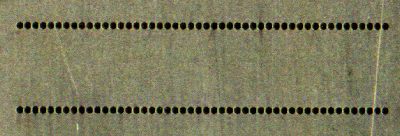
(2 of the 6 rows of nozzles in a 1160 print head)
Unclogging epson
inkjet heads.
Desperate times call for
desperate measures.
(20-october-2002)
More printer dramas at http://nerdipedia.com/

(2
of the 6 rows of nozzles in a 1160 print head)
An almost random collection of thoughts on getting the buggers to print again.
Last month I posted this in a couple of newsgroups.
|
(14'th sept 2002) |
This had a few responses, the most interesting was....
|
I just cleaned a Canon 8200 with a strong HOT solution of Ammonia and water. I had used windex before, but it didn't touch this clog. I also used a piece of rubber tubing to press onto the outlet and suck the solution up into the capillaries. Since the cleaning I have printed about 20 pages of color photos. Not a clinker in the bunch. {except where the picture was bad to start with ;-(( } |
Getting these printers working can be a very frustrating task.
What works one time doesn't another. Sometimes it just needs
patience, other times chemistry and sometimes (though I've managed to
avoid it) the printer needs dumping.
After a long unsuccessful
cleaning session one tends to become desperate and a little
irrational.
The full moon is in Libra/Aries tomorrow - I'd better
have the windex ready.....
Some of the suggestions I've found
online are not relevant to me because I run pigment and because I run
CIS.
My latest project “Project light black”. PLB has caused the worst clogging ever, whether I can save the printer remains to be seen (it died). I knew this could happen which is why I did the tests in my 1160 and not my new 2100p.
In the (ongoing) process of trying to save the printer I tried a
few things I haven't seen elsewhere.
Before proceeding readwww.inkjetart.com/tips/cleaning.html
if you haven't already.
You probably should also see my
1160 CIS page
My experimenting with PLB hints at a possible problem with one of
the suggestions.
The one that says “Repeat step 1 and step 2
with denatured alcohol to avoid any residue which might cause
problems with the ink to follow.”
The thing is my “clog
from hell” happened from running pure(ish) methanol/ink mix.
I've also found pure water/ink to be bad. My best results have been
from a 30:70 alcohol water mix and mentholated spirit seem a little
better than methanol. I doubt dye based inks have this problem.
If the “denatured alcohol” is blown away with canned air then it probably isn't an issue. If the windex blown away you probably don't need the “denatured alcohol”.
I'm speculating along with most people. I haven't pulled apart a print head (if that is even possible) so I don't know the exact geometry. I presume there is a largish ink channel feeding the small piezos. The head appears to have a fairly small volume micro/litres not Milli-litres. When changing ink colors they seem to flush out easily so they don't seem to have pockets to trap old ink.
Knowing the real geometry could be handy when diagnosing problems. One school of thought says that randomly clogged jets are caused by gas bubbles. This may be true but could large lumps of foreign matter floating around also do this? I don't know.
If there is a large bit of muck in there no amount of
cleaning/blowing/windexing is going to help.
I don't use
compressed air, I use a syringe. With a syringe you can see if there
is a flow and feel the force required, I'm not sure how much pressure
is safe. I've found that when I can't get anything into the head I
can always suck back and then I can.
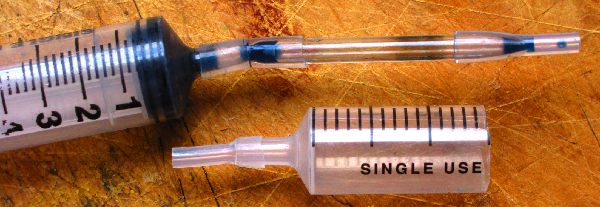
Here
are some of my tools. On top is a 10ml syringe with a glass tube
extender. The joint is silicone tube. The other piece of tube is
multipurpose. One function is to fit directly over the ink spikes.
The cut down syringe can be attached to the spike as a reservoir to
feed solution into the head during cleaning cycles etc. A cover over
the top would be good to prevent stuff splashing out.
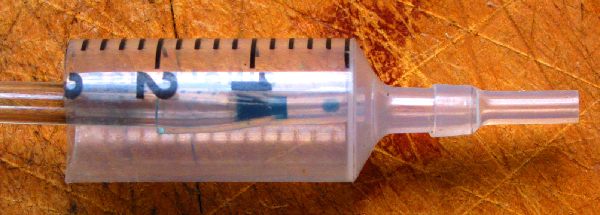
The
second use for the multipurpose tube is to go inside the reservoir to
allow stuff to be sucked out without removing the reservoir.
People using cartridges sometime make cleaning carts by filling MT ones with windex – sounds like a good idea to me. Having a trace of ink left lets you see which jet are clear. However if like myself you use pigment you probably don't won't this mixed with cleaner. So I mixed some old dye based ink with my windex instead.
The cleaning.htmlhas already mentioned that not all cleaning cycles are equal. You should also be aware that a “charging” cycles is different as well. A charging cycle happens when the printer thinks it has had a cartridge change. In the 1160 it is triggered by the lid switches on the head. In some it senses the “inkchips” are different. On the 2100p unplugging/replugging it triggers this - expect when there is a chip reading MT. If you just want the printer to pump ink the charge cycle is probable better than a cleaning cycle (some cleaning cycles do pump a lot of ink but most don't).
My other perhaps silly innovation is to give the head a bath.
I
do NOT recommend this!!
I did this for 2 reasons.
Firstly
I wanted to know if the air I was sucking out of the nipple was
coming thru the nozzles and not a leak somewhere.
Secondly I
thought it might be good the suck solution thru in the reverse
direction and possibly dislodge crude which wouldn't fit thru the
nozzles.
Making a bath turned out to be very simple (for the 1160
at least). What I did is moved the head out manually and then I
pulled some plastic sheet (a sandwich bag actually) under the head
till it reach the metal rod the head slides on. I raised the sides by
packing sponge under the bag and poured windex into it. This worked
and I sucked windex up thru the head. The windex was very black from
the ink it had dissolved of the bottom of the head. If I do it again
I'll cleaned the head first with tissue.
I won't swear that this
did anything useful – it is hard to tell. It may even be
dangerous – there could be wires down there for all I know. I
didn't seem to do any harm though.
The patient died on the 22'nd of October– cause of death unknown.
UPDATE – The head was
probably OK!!! The printers go into the “error” mode when
it think the ink pad needs changing. This can be reset manually –
I did not know this at the time.
See - http://www.mwords.co.uk/pages/printers/printersHowDoI.htm#ResetPrinter
I seemed to be making progress, I tried a few other cleaning chemicals and had most nozzles firing. Then the printer just stopped and flashed it's lights at me. It could be that the head failed some sort of self-test or it could be a totally different fault. I have no way of knowing. It is safest to assume I killed the head but this may not be the case. When it stopped two thoughts came to mind. The first was that liquid had splashed on the main circuit board and shorted something out. The electronics turn out to be quite well protected from the wet areas. The second thought was that all the liquid that disappeared into the bowels of the printer had filled a reservoir and tripped a level switch. Also not true the liquid is soaked up by a huge piece of felt which seems to fill the full length of the pan.
Off with it's head.
Had I know that the head comes out so relatively easily
I would have been out long ago. I've always wonder how it works. The
basic piezo design is known and a low-res image of the first page of
a patent is athttp://www.delphion.com/cgi-bin/viewpat.cmd/US05513431__?MODE=fstv
What I didn't know is what the underside of the head looked
like, how the plumbing worked and how it was primed.
The bottom looks like this, you can click thru for a better look. You can see the 6 rows of nozzle, 3 for black and one each C,M + Y. Six color printers might use the same head. On the right is a plastic ruler showing a mm scale. It is a big silicon chip.
A this is a closeup of two rows of nozzles. It would be interesting to compare it with a new head to see if the holes have eroded.
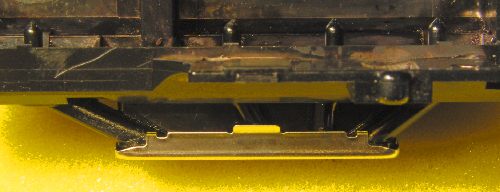
This is the front view, the four spikes which go into the ink carts are at the top and the tubes running down to the head are visible. I had expected more. I thought there might be some pump or bypass valve for cleaning/priming but not so (more on this below).
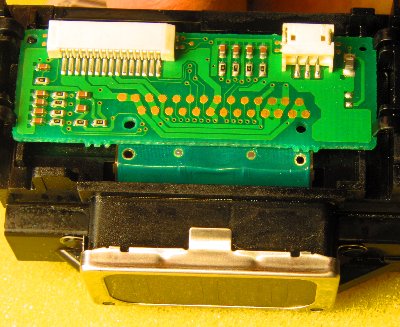
This is this interface board which take signals from the ribbon cables and routes them to the head. The 3 pin socket presumably goes to the cartridge change switches.
Now it all makes
sense (well mostly).
In my CIS the ink is at reduced
pressure, the same is probably true of cartridges because you have to
suck the ink out of the foam. The 2100 actually has a pressure
regulator built into the cartridges which the printer sucks against.
Once filled with ink the capillary effect will suck the ink thru the
system. What I didn't know was how you got the ink into the nozzle to
start with. The answer is simple, the printer uses a vacuum pump.
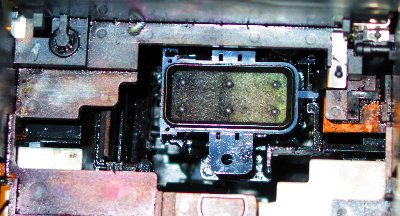
This is a shot taken thru the hole where the head
usually is when parked. It shows the rubber cup which comes up
against the head. This is the foam block you windex to un-jam the
jets. What isn't obvious is that the tube coming off the bottom is
not just a drain, it goes to a device which I presume is a pump. This
is driven by the paper advance motor.
On the inkjet art page
it says.
“You must stay in the utility menu for the
printer to use increased pressure, you must also run a nozzle check
between cleaning cycles, or the printer won't actually clean its
self, just spin the roller. Each time you repeat a cleaning cycle
without exiting the menu, the printer will use increased pressure.”
I
don't mean sounds over critical, I'm glad he put this info online for
everyone. But I think it is wrong (for the 1160 at least). The
printer does not “apply pressure” - it sucks. It does not
“just spin the roller” it is spinning the pump. This
means the print head is never pressurized and the maximum pressure
difference across it is one bar. With a syringe you can apply much
higher pressure than that. The head may not be designed to take it
but it seems to handle it.

So
was the head clogged?
No it wasn't. On the high res image I
can count all 48 jets are squirting. I think there may be more to it
than blocked jets and bubbles. I think it may have to do with surface
coatings and surface tension but it will remain a mystery to me a
while longer.
Some more thoughts.
On Powell's page he digs a little further and reveals a filter below the ink spikes. If this were clogged it could have symptoms like I was seeing. Also if clumps formed inside the head (say pigment particles clumping together) there is no way to get them out. You would have to find a way to break the clumps up, remove the filter or add an extra opening to the ink line for sucking them out. This is not out of the question once you've reached to “bin” stage.
The next Patient.
A bit of a non-event really. I was given a stylus 400. It had not been used for a few months. Some heads were clogged. Windex on the pad - 2 hours and several cleaning cycles later all jets were ok. I continued with PLB and promptly clogged one head completely. Next day I suck it out, put in a different ink mix and easily got all jets working again.
Powell Hargrave has a similar page herehttp://members.shaw.ca/hargravep/head.htm
Ciao Eddie, aka inky.